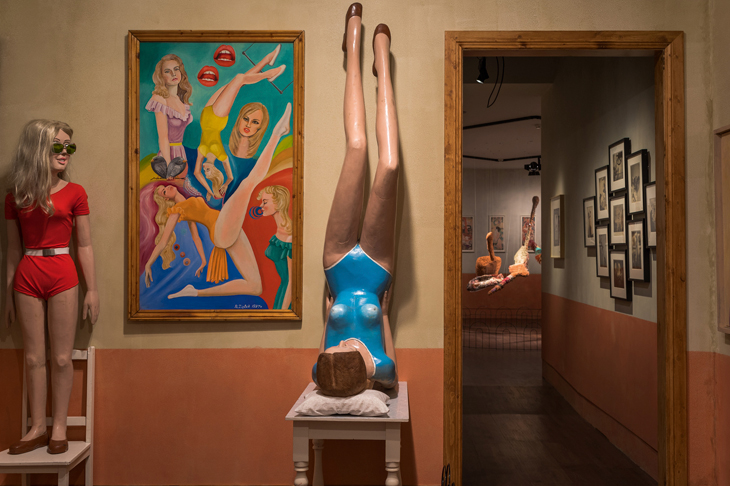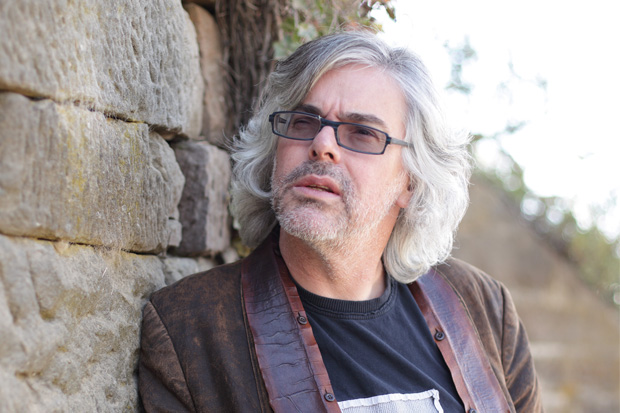In the 1950s a childless couple in the deserts of California set about creating their own family. Calvin and Ruby Black carved more than eighty life-sized wooden dolls, dressed them in peasant smocks and gave them names and personalities. The Blacks never thought of themselves as artists. But over half a century later Dollland – the collection of their ‘children’, some sporting sad little smiles, others downturned lips and dead eyes – is the grand finale in The Museum of Everything, Australia’s largest ever dedication to ‘private art’ now at MONA in Hobart.
‘It’s totally loveable – look at them!’ declares the Museum’s founder, eccentric Englishman James Brett, who is showing us around wrapped up in a tweed scarf and who sports pebble shaped tortoiseshell glasses. I glance again at the frozen marionettes. They look sinister. Brett laughs: ‘Go and walk through a contemporary art fair and tell me fifty per cent of it isn’t creepy. Art is macabre by nature.’
The Museum of Everything – gargantuan in scope – sits in a mock higgledy-piggledy Georgian terrace in MONA’s gloomy basement, replete with arched brick entrance, fusty net curtains and an old fashioned library. It’s a ‘posh house gone to seed,’ modelled on Brett’s former London home in Primrose Hill. Inside, 30 rooms are stuffed with 1,500 artworks from 200 artists, who date from the 1800s to today. The Museum has no fixed abode: since launching in 2009 it has popped up everywhere from London’s Tate Modern to the Venice Biennale. Brett may be short but his larger-than-life presence (he has a penchant for declarations such as ‘holy moly!’) is everywhere.
Inside are artists who have never attended art school, who aren’t hung in galleries or museums, and who, on the whole, don’t dominate art fairs. Like Calvin and Ruby Black they created for themselves, in order to touch the divine, to make life that little bit more tolerable, or just because they could. At the heart of The Museum of Everything, then, is a debate about what art is and who has the right to be called an artist.
‘It’s not so much whether it’s good or bad because that’s subjective,’ says Brett, peeling off his glasses. He uses them to methodically stir a Lemsip into a delicate china teacup of piping hot water. ‘It’s about the origin and maker.’
‘People who make their work privately, people who are not taught art, people who are somehow outliers even to their own communities, people with disabilities supposedly, people with unusual ways of communicating,’ he continues. ‘They often don’t provide an easy context for their material. They don’t say, “Hi my name is John, my work is about the way the river runs in life and it’s in an edition of twenty.” Brett refuses to use the terms ‘outsider art’, ‘primitive art’ or ‘folk art’ and has no time for art’s snobby gatekeepers – the curators, gallerists, historians – who have a vested interested in conjuring up an aura around what is elite, building structures to shut others out.
The Museum of Everything is a blockbuster show, attracting more than a million visitors worldwide; yet it is not without detractors. Art historians, Brett admits, are particularly appalled. ‘The reason we do it with such density is that it’s impossible to deny the validity of so much making and its place in some unwritten history. It’s about writing those histories.’ He pauses. ‘It’s political.’
This new history includes Karl Junker, who ‘carved an entire house in Germany for a family he never had,’ and the Russian landscape gardener Vassily Romanenkov who died on the night of The Museum of Everything’s opening in Moscow – the first time his works had ever been seen in a contemporary art space. There’s Australian Alan Constable, who is deaf, blind, and cannot express himself in verbal or written language, ‘so the context of Alan’s work is trapped inside Alan.’ And Indian Nek Chand who secretly built a vast rock garden of pottery figures, which he hid for 18 years, near a gorge in the forests of Chandigarh because he ‘saw god in the stones.’
Some artists lay undiscovered for decades. Josef Karl Rädler was sent to an Austrian mental institute in 1905. Everyday from his prison he viscerally painted his world, unknown and unseen to the outside, in spellbinding watercolours. In the 1960s, when they tore the hospital down, they discovered his works in the trash – all 400 of them.
Brett, whose background is in filmmaking and claims to be a ‘born naysayer’, has ‘written’ the exhibition rather than curated it – ‘like a story or a film this show has a beginning, middle and end.’ The first rooms marks time, space and the cosmos before viewers walk through to rooms touching on identity, faith and belief, then love, sex and lust before doing a turn back to earth, architecture, landscape and the home. Along the way there are a host of zany characters and glittering marvels: a favourite is Perth electrician Stan Hopewell’s gaudy pink shrine dedicated to the Last Supper, topped by fairies with fluttering wings like moths. Bringing each work alive is Brett’s colourful language. Kentucky painter William Hawkins, who depicted scenes of rusty red pack horses trekking over snowy landscapes, is a ‘southern hunter, truck driver, scrap merchant and self-confessed pimp.’ He is nothing compared to 20th century photographer William Mortensen, an ‘expressionist, fetishist, Hollywood hack, startlet snapper, and Ansel Adams’ anti-Christ’ whose A Pictorial Compendium of Witchcraft delighted in showing twisted naked girls plagued by devils.
So who owns all these works? Brett refuses to say. ‘There’s nothing worse than going to a show and seeing a list of [who owns what] – all it does is make you think what a bunch of wankers,’ he scoffs. ‘Ownership is a myth created by the media… to pacify the wealthy.’
Next Brett wants to travel around the breadth of Australia to try and discover new hidden treasures. Walking through the museum, I wonder out-loud if these works – so many of which were squirrelled away, out of sight, in houses or cupboards or drawers – are the artistic equivalent of a tree falling in a forest, with no one nearby to hear it. Does it make a sound? Is it enough just to create and not to be seen? Does art need an audience to make it art? Brett isn’t sure. He only knows that he has one job: ‘To find those trees.’
Got something to add? Join the discussion and comment below.
Get 10 issues for just $10
Subscribe to The Spectator Australia today for the next 10 magazine issues, plus full online access, for just $10.
You might disagree with half of it, but you’ll enjoy reading all of it. Try your first month for free, then just $2 a week for the remainder of your first year.














Comments
Don't miss out
Join the conversation with other Spectator Australia readers. Subscribe to leave a comment.
SUBSCRIBEAlready a subscriber? Log in